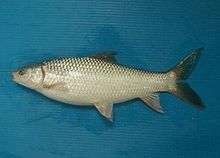Mrigal carp
| Mrigal carp | |
|---|---|
 | |
| Scientific classification | |
| Kingdom: | Animalia |
| Phylum: | Chordata |
| Class: | Actinopterygii |
| Order: | Cypriniformes |
| Family: | Cyprinidae |
| Genus: | Cirrhinus |
| Species: | C. cirrhosus |
| Binomial name | |
| Cirrhinus cirrhosus (Bloch, 1795) | |
| Synonyms | |
|
Cirrhinus mrigala (F. Hamilton, 1822)[2] | |
The mrigal carp (Cirrhinus cirrhosus, also Cirrhinus mrigala[2]), also known as the mrigal and the white carp, is a species of ray-finned fish in the carp family. Native to streams and rivers in India, the only surviving wild population is in the Cauvery River, leading to its IUCN rating as vulnerable.[1] It is widely aquafarmed and introduced populations exist outside its native range.[1][3] It reaches a maximum length of 1 m (3.3 ft).[4]
Aquaculture
Mrigal is popular as a food fish and an important aquacultured freshwater species throughout South Asia.[5] It is widely farmed as a component of a polyculture system of three Indian major carps, along with roho labeo and the catla. The introduction to aquaculture across India started in the early 1940s and in the 1950s and in the 1960s to other Asian countries. The mrigal carp fails to breed naturally in ponds, thus induced breeding is done.[1]
The Indian carps are considered as a delicacy compared to other exotic carp species also cultured in Asia, and sell for higher prices.[1] Reported annual aquafarming production numbers of mrigal carp since the early 1990s have varied between 250,000 and 550,000 tonnes, with no clear trend. India and Bangladesh are the largest producers.[3]
Habitat and ecology
Mrigal is the benthopelagic and potamodromous plankton feeder. It inhabits fast flowing streams and rivers, but can tolerate high levels of salinity. Spawning occurs in marginal areas of the water bodies with a depth of 50 to 100 centimetres (20 to 39 in) over a sand or clay substrate. A 6-kilogram (13 lb) female can lay a million eggs. This fish has a rapid growth rate; by the age of two individuals can reach a length of 60 centimetres (24 in) and can weigh as much as 2 kilograms (4.4 lb).
References
- 1 2 3 4 5 Rema Devi, K.R. & Ali, A. (2011). "Cirrhinus cirrhosus". IUCN Red List of Threatened Species. Version 2012.2. International Union for Conservation of Nature. Retrieved 9 May 2013.
- 1 2 The cultured mrigal carp has been cited as Cirrhinus mrigala and is so still treated by FAO, whereas sources such as FishBase, IUCN Red List and Eschmeyer's Catalog of Fishes now consider C. cirrhosus and C. mrigala as distinct species
- 1 2 FAO (2014). "Cirrhinus mrigala (Hamilton, 1822)". Cultured Aquatic Species Information Programme. FAO Fisheries and Aquaculture Department. Retrieved 9 May 2014.
- ↑ Froese, Rainer and Pauly, Daniel, eds. (2014). "Cirrhinus cirrhosus" in FishBase. May 2014 version.
- ↑ Development of freshwater fish farming and poverty alleviation - A case study from Bangladesh
- Froese, Rainer and Pauly, Daniel, eds. (2014). "Cirrhinus mrigala" in FishBase. April 2014 version.
